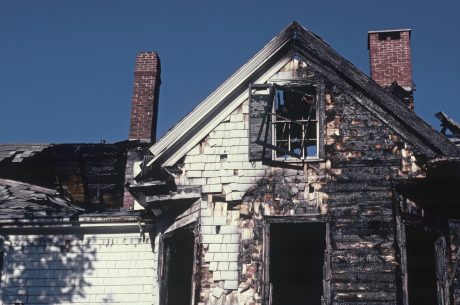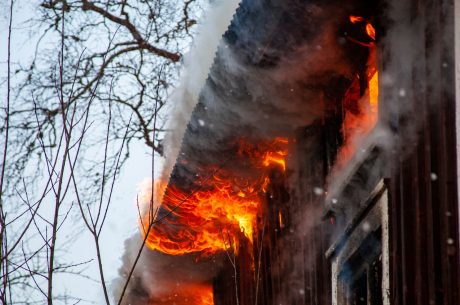A house fire can leave more than just visible destruction; it disrupts your entire sense of security and comfort. What happens next can feel overwhelming, especially when emotions are high and decisions need to be made quickly. That’s why having a clear understanding of the restoration process can make a huge difference.
This complete guide walks you through every phase, from safety checks and insurance to cleanup, permits, and structural repairs. Whether you’re dealing with a minor incident or a total rebuild, you’ll find step-by-step support for home rebuilding after fire, backed by smart choices and long-term planning.
Getting Started After a Fire
The early hours after a fire are filled with urgency and emotion. Your family’s safety comes first, but knowing what to do next can help reduce stress and loss. Once the fire department clears the site, avoid going in until you know it’s structurally safe.
Immediately contact your insurance company to begin your claim. Take detailed photos of the damage, list everything you lost, and start the paperwork. Fast documentation speeds up the financial support you need for home rebuilding after fire. Don’t forget to secure your home. Board broken windows, tarp the roof, and use fencing if needed. Preventing further damage now gives you a more stable platform for recovery.
Inspect the Damage Carefully
Understanding what’s repairable and what isn’t is a critical early step. A licensed fire inspector can spot hidden damage to the foundation, wiring, support beams, and plumbing. Without this, the rebuild may start on an unsafe base.
Inspection results help you prioritize what needs to be torn down, rebuilt, or reinforced. Before making any construction decisions, rely on expert assessments to ensure your post-fire home rebuild is safe and compliant with building codes.
Clean the Site the Right Way
Fire cleanup is hazardous and should be handled by certified professionals. toxic soot, ash, melted materials, and moisture from houses all pose serious health and structural risks. This stage must be done thoroughly before any rebuilding starts.
What to Expect During Cleanup:
- Remove toxic residue: Professionals clean up smoke, soot, and chemicals using specialized tools. They work fast to eliminate harmful particles that settle deep into surfaces.
- Prevent mold early: Firefighting often leaves water damage behind. Crews bring in industrial dryers and remove wet materials to stop mold from forming inside walls or floors.
- Dispose of debris safely: Cleanup teams collect and dispose of dangerous items like glass, melted wiring, and metal. They follow local environmental laws to prevent further contamination.

Permits and Insurance After a Fire
Before construction begins, you need permits for plumbing, electrical, roofing, and structural work. Failing to secure proper approvals can delay your rebuild and even result in fines. Most areas also require multiple inspections throughout the project.
Make sure your insurance policy aligns with your rebuilding plans. Some upgrades, like solar panels or luxury materials, may not be fully covered. Clear planning ensures your home rebuild after a fire stays aligned with legal requirements and financial expectations.
Rebuild the Structure Safely
The heart of the rebuild starts here. Structural restoration after a fire includes replacing load-bearing walls, damaged foundations, and compromised supports. This ensures your home is safe to live in and can pass inspection.
Professionals will check for warped beams, cracked foundations, and melted or scorched framing. Everything that no longer meets safety standards must go. The rebuild must meet updated local building codes and should support better fire resistance.
Choose Fire-Safe Materials
Now is the best time to rebuild smarter. During home rebuilding after a fire, many homeowners take the opportunity to upgrade their materials for fire resistance, durability, and insurance benefits.
Fire-Resistant Materials to Use:
- Metal roofing: This material resists flames and heat far better than shingles. It also lasts longer and offers strong protection in wildfire-prone zones.
- Cement board siding: Unlike wood or vinyl, cement board won’t ignite or melt. It’s durable and adds a solid layer of defense around the house.
- Tempered glass windows: These are four times stronger than regular glass. They resist breaking heat and help reduce smoke penetration during fires.
Replace Home’s Systems After a Fire
A fire often destroys more than what is visible. Electrical wires may melt, plumbing can split, and HVAC systems could push smoke into every room if left untreated. All internal systems must be tested and replaced where needed. This is a key part of structural restoration after fire, as faulty systems could compromise safety later. Use this time to upgrade to energy-efficient, code-compliant replacements for improved safety and long-term performance.
Restore Interior Spaces
Once your home’s structure and systems are safe, you can start restoring the interior. At this stage, you’ll add drywall, fresh paint, new flooring, lighting, and cabinets, turning your house back into a comfortable, welcoming home.
Use fire-rated drywall, low-VOC paint, and mold-resistant insulation to reduce indoor toxins and prevent moisture damage. Smart, healthy materials are an essential part of sustainable home rebuilding after a fire.
Pass the Final Inspection
Your home isn’t ready for re-entry until it passes a final inspection. Officials will confirm that the structural work, electrical systems, and fire prevention measures all meet local safety codes. Once you receive a certificate of occupancy, you’re officially cleared to move in. That’s the final milestone of your home rebuilding after fire journey, and a symbol of recovery and resilience.
Prevent Future Fires
The final step is about fireproofing your house. After you rebuild, take small but powerful steps to protect your family and investment from fire risks in the future.
Easy Habits to Keep Your Home Safe from Fire:
- Test smoke alarms: Place them in bedrooms, hallways, and kitchens. Test them monthly, replace batteries twice a year, and keep extras on hand.
- Use extinguishers: Place one on every floor, especially in kitchens and garages. Make sure every adult in the home knows how to use it correctly.
- Maintain landscaping: Trim trees and shrubs away from the house. Use gravel, stone, or bare soil within five feet of the foundation to reduce fire spread.
Conclusion
Fire damage doesn’t have to mean losing your home; it can be the start of something better. Every step you take, from initial safety inspections to fully restoring the structure after a fire, helps create a safer, stronger place to live. By choosing smarter materials, updated systems, and working with the right professionals, rebuilding after a fire can lead to a more resilient and secure home. Focus on each stage as it comes, knowing your efforts contribute to a meaningful recovery.
FAQs
Q1: Can I change my floor plan while rebuilding?
A: Yes. You can redesign layouts or add new features, as long as your changes follow local zoning laws and your budget allows it.
Q2: Will insurance pay for temporary housing?
A: Most policies include “Loss of Use” coverage, which pays for rent, hotels, or even meals while your home is under construction.
Q3: Who handles structural restoration after a fire?
A: Typically, a structural engineer manages the project. They work with general contractors and code inspectors to rebuild safely.
Q4: Are smart home systems a good post-fire upgrade?
A: Yes. Devices like smart smoke alarms, automatic gas shutoffs, and remote monitoring can enhance both safety and convenience.
Q5: How can I keep my rebuilt home fire safe?
A: Maintain detectors, schedule yearly inspections, and practice fire drills. Prevention is the easiest way to protect your investment.



